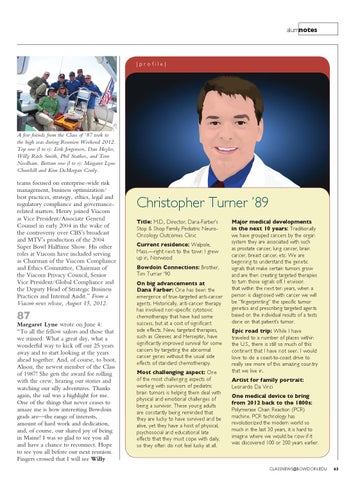alumnotes
|profile|
A few friends from the Class of ’87 took to the high seas during Reunion Weekend 2012. Top row (l to r): Erik Jorgensen, Dan Heyler, Willy Ritch Smith, Phil Stathos, and Tom Needham. Bottom row (l to r): Margaret Lyne Churchill and Kim DeMorgan Conly.
teams focused on enterprise-wide risk management, business optimization/ best practices, strategy, ethics, legal and regulatory compliance and governancerelated matters. Henry joined Viacom as Vice President/Associate General Counsel in early 2004 in the wake of the controversy over CBS’s broadcast and MTV’s production of the 2004 Super Bowl Halftime Show. His other roles at Viacom have included serving as Chairman of the Viacom Compliance and Ethics Committee, Chairman of the Viacom Privacy Council, Senior Vice President/Global Compliance and the Deputy Head of Strategic Business Practices and Internal Audit.” From a Viacom news release, August 15, 2012.
87
Margaret Lyne wrote on June 4: “To all the fellow sailors and those that we missed: What a great day, what a wonderful way to kick off our 25 years away and to start looking at the years ahead together. And, of course, to boot, Alison, the newest member of the Class of 1987! She gets the award for rolling with the crew, hearing our stories and watching our silly adventures. Thanks again, the sail was a highlight for me. One of the things that never ceases to amaze me is how interesting Bowdoin grads are—the range of interests, amount of hard work and dedication, and, of course, our shared joy of being in Maine! I was so glad to see you all and have a chance to reconnect. Hope to see you all before our next reunion. Fingers crossed that I will see Willy
Christopher Turner ’89 Title: M.D., Director, Dana-Farber’s Stop & Shop Family Pediatric NeuroOncology Outcomes Clinic Current residence: Walpole, Mass.—right next to the town I grew up in, Norwood Bowdoin Connections: Brother, Tim Turner ’90 On big advancements at Dana Farber: One has been the emergence of true-targeted anti-cancer agents. Historically, anti-cancer therapy has involved non-specific cytotoxic chemotherapy that have had some success, but at a cost of significant side effects. New, targeted therapies, such as Gleevec and Herceptin, have significantly improved survival for some cancers by targeting the abnormal cancer genes without the usual side effects of standard chemotherapy. Most challenging aspect: One of the most challenging aspects of working with survivors of pediatric brain tumors is helping them deal with physical and emotional challenges of being a survivor. These young adults are constantly being reminded that they are lucky to have survived and be alive, yet they have a host of physical, psychosocial and educational late effects that they must cope with daily, so they often do not feel lucky at all.
Major medical developments in the next 10 years: Traditionally we have grouped cancers by the organ system they are associated with such as prostate cancer, lung cancer, brain cancer, breast cancer, etc. We are beginning to understand the genetic signals that make certain tumors grow and are then creating targeted therapies to turn those signals off. I envision that within the next ten years, when a person is diagnosed with cancer we will be “fingerprinting” the specific tumor genetics and prescribing targeted agents based on the individual results of a tests done on that patient’s tumor. Epic road trip: While I have traveled to a number of places within the U.S., there is still so much of this continent that I have not seen. I would love to do a coast-to-coast drive to really see more of this amazing country that we live in. Artist for family portrait: Leonardo Da Vinci One medical device to bring from 2012 back to the 1800s: Polymerase Chain Reaction (PCR) machine. PCR technology has revolutionized the modern world so much in the last 30 years, it is hard to imagine where we would be now if it was discovered 100 or 200 years earlier.
CN Fall 12.indd 63
CLASSNEWS@BOWDOIN.EDU
63
11/2/12 11:38 AM
